The principle and application of holographic technology-Dr. Liu Chao
2020-12-16
1. The birth of "holographic"
"Holography" is translated from the English "Holography/Hologram", where "Holos" means "all" in Greek. Holography/Hologram (holography/hologram) was invented by Hungarian-born British physicist Dennis Gabor in 1948. This pioneering work was published on Nature [1].

Dennis Gabor
Hungarian-born British physicist Dennis Gabor (Dennis Gabor); 1947, patent authorization (GB685286, UK); 1948, Published by Nature (Vol. 16)[1]; 1949, Proc. R. Soc. Lond. A was published and named "Hologram" (Vol. 197) [2]; 1971, Nobel Prize in Physics.
A small detail worth mentioning: Although this idea was publicly published in 1948, the name "Hologram" came from an article published on Proc. R. Soc. Lond. A the following year, and the article was called "Microscopy" by reconstructed wave-fronts"[2].

The picture above is a passage about naming the article. The translation is: because this article often needs to use the diffraction pattern under divergent coherent illumination, a special name is introduced for it to distinguish it from the diffraction pattern sample body. It is considered a complex function. The name "Hologram" is not unreasonable, because a photo contains all the information needed to reconstruct an object, and can be two-dimensional or three-dimensional.
The first step of holographic technology is to use the principle of interference to record the light wave information of the object, that is, the shooting process: the object to be photographed forms a diffuse object beam under laser irradiation; the other part of the laser is used as a reference beam to be shot on the holographic film and superimposed with the object beam Interference is generated, and the phase and amplitude of each point on the object light wave are converted into spatially varying intensity, so that all the information of the object light wave is recorded by the contrast and interval between the interference fringes [1]. After the negative film with interference fringes is developed and fixed, it becomes a hologram, or hologram; the second step is to use the principle of diffraction to reproduce the light wave information of the object. This is the imaging process: the hologram is like a For complex gratings, under the irradiation of coherent lasers, the diffracted light waves of a linearly recorded sinusoidal hologram can generally give two images, namely the original image (also called the initial image) and the conjugate image. The reproduced image has a strong stereoscopic effect and a real visual effect. Each part of the hologram records the light information of each point on the object, so in principle, each part of it can reproduce the entire image of the original object, and multiple exposures can also record multiple different images on the same film. And it can be displayed separately without interfering with each other.
Features and advantages
1. The reconstructed three-dimensional images are conducive to the preservation of precious art materials for collection.
2. Every point during shooting is recorded on any point of the hologram, even if the photo is damaged, it does not matter.
3. The holographic photo has a strong three-dimensional effect and a vivid image. It can be displayed in various exhibitions with the help of a laser, and very good results will be obtained.
Technology Type
There are three types of projection technology:
1. Air projection and interactive technology: This was invented by a 29-year-old graduate student in science and engineering named Chad Dyne in Massachusetts, USA. It is a milestone in display technology. It can project images with interactive functions on the wall formed by airflow. This technology is derived from the principle of the mirage. The image is projected on the water vapor. Due to the unbalanced molecular vibration, it can form a highly layered and three-dimensional image.
2. Laser beam technology: Japanese Science and Technology company invented a 3D image that can be projected by a laser beam. This technology uses nitrogen and oxygen to disperse in the air, and the mixed gas becomes hot Paste-like substance and form a short-lived 3D image in the air. This method is mainly achieved by continuous small blasting in the air.
3. 360-degree holographic display: It is currently announced by the researchers of the Institute of Innovation and Technology of the University of Southern California that they have successfully developed this technology to project the image on a high-speed rotating mirror to achieve a three-dimensional image, but there will be some Danger.
It is no exaggeration to say that holographic technology encompasses the future. Whoever uses this technology first will enter the ranks of advanced technologies in the future. Holographic projection technology is a reverse display of holographic photography, essentially forming a three-dimensional image on the air or on a special three-dimensional lens. Unlike flat screen projection that only achieves a three-dimensional effect on a two-dimensional surface through perspective, shadow and other effects, holographic projection technology truly presents 3D images, which can view different sides of the image from any angle of 360°.
The principle of holography is applicable to various forms of waves, such as X-rays, microwaves, sound waves, electronic waves, etc., as long as these waves have sufficient coherence when forming interference patterns. Optical holography is expected to be used in three-dimensional movies, television, exhibitions, microscopy, interferometrics, projection lithography, military reconnaissance and surveillance, underwater detection, metal internal detection, preservation of precious historical relics, artworks, information storage, and remote sensing , The research and recording of transient phenomena and transient processes (such as explosion and combustion) with extremely rapid physical state changes have been widely used [3].
2. The principle of "holographic"
2.1 Why is it called "holographic"
2.1.1 The amplitude (intensity) information is where is bright and dark:
Generally what we call photography (photographing, photography) refers to imaging a space object on a plane according to the principle of geometric optical imaging, and then recording the amplitude (intensity) of the light wave on the plane. As shown in the following simple schematic diagram, take a picture of the candle flame with a camera, and what you get is the amplitude information of the object light wave (where bright and where dark).

2.1.2 The wavefront (phase) information is where is high and where is low:
In fact, in addition to the amplitude, the object light wave also has a wavefront. The wavefront contains the phase information of the object (where it is high and where it is low).
For the understanding of wavefront (phase), please refer to:

What would it look like if the phase information of the candle flame were drawn?
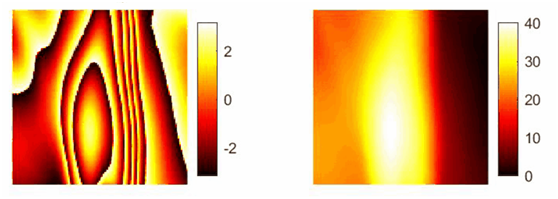
Candle flame phase diagram: wrapping (left), unwrapping (right)
The above picture is taken from an article [3], the one on the right is the phase information of the candle, the brighter the color means higher, the darker the color means lower. (As for what are so many "folds" in the picture on the left? Please refer to [3]. If you are interested, you can introduce "folds" separately.)
2.1.3 If there is both amplitude (intensity) information and wavefront (phase) information, it is called "holographic":
If you can record the amplitude and phase of the object light wave and reproduce it under certain conditions, you can see the three-dimensional image containing the object's intensity and phase. Therefore, it is called "holography", that is, "all information", that is, "intensity and phase."
2.2 How to realize "holographic"
Speed Reading Version: The phase information cannot be directly stored in the photo; the reference light wave is introduced to interfere with the object light wave, and the phase information is stored in the fringes; the hologram can be reproduced (diffracted) by the reference light wave.
2.2.1 The phase information cannot be saved directly in the photo:
It's easy to save intensity information, just find a camera and take a photo. What about phase information? Why can't the phase information be directly recorded in the photo?

The expression form of the complex amplitude of the object light wave is as follows (this knowledge point will be found in optical books):
O(x,y)=O_0 (x,y)exp[iφ_0 (x,y)]
The expression of light intensity is like this:
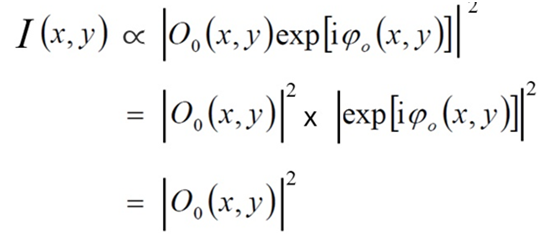
At the end of the calculation, why is the phase term missing (meaning there is no phase term in the intensity of the object light wave)? because:

2.2.2 Introduce the interference between the reference light wave and the object light wave, and save the phase information in the fringe:
Since the phase of the object light wave cannot be stored directly, then find a reference light wave (plane light wave) with known intensity and phase information and put it together, is it all right?
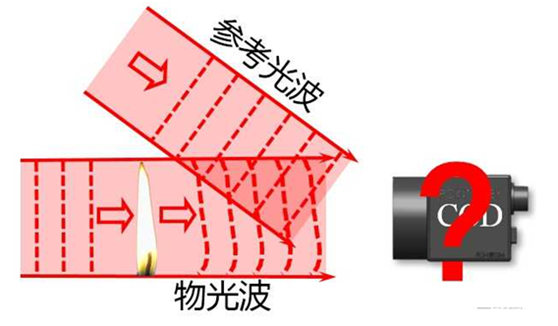
What is the picture (hologram) we get at this time?

After several times of magnification, black and white stripes can be seen, and the phase information is stored in the shape of the stripes. The intensity information itself is already contained in the hologram, which is reflected in the light and dark distribution of the fringe itself (not the fringe shape).
Why is there phase information in the hologram? Find a plane light wave as a reference:
When the object light wave and the reference light wave are superimposed together, the intensity expression of the composite light wave is as follows:

2.2.3 By illuminating the hologram with the reference light wave, the light wave of the object can be reproduced (diffracted):

At this time, you can look up and see the three-dimensional information of the candle.
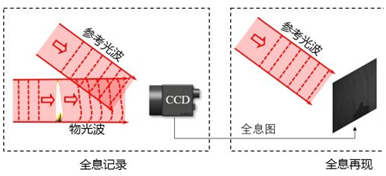
You know, the reproduced light wave field is exactly the same as the light wave field of the candle itself, so what you see is the same as the real candle flame (you just can't touch it).
For the digital method of hologram reconstruction, please refer to:

3. The main application of "holographic"
3.1 Measurement of phase and shape (microscopic)
A very large area, this is mainly for things that look transparent (such as cells, biological tissues, flow fields, etc.), and those that need to know the surface topography (chips, MEMS, etc.).
3.2 Holographic storage
Use holograms to store text or picture information: information with different polarization states, different wavelengths, and different angles can be stored in a hologram at the same time, so it is characterized by large capacity and high density. However, it is too sensitive to the interference of vibration and ambient light and has not yet been applied on a large scale.
3.3 Holographic interferometry
Simply put, before the sample changes, measure phase A once, after the sample changes, measure phase B again, and the phases obtained twice can be subtracted to get the change of the sample and realize non-destructive testing (deformation, damage, etc.).
3.4 Holographic display
This is the most familiar to everyone, the picture in the previous section is the simplest holographic display.
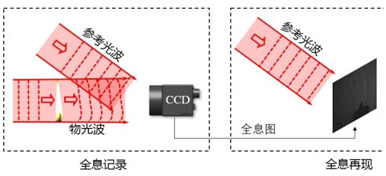
This can see up to 180 degrees (in fact, far more than 180 degrees). If you want to restore the object in 360 degrees, the most stupid solution is to take multiple angles, and then reproduce the object light waves according to their respective angles, as shown below:
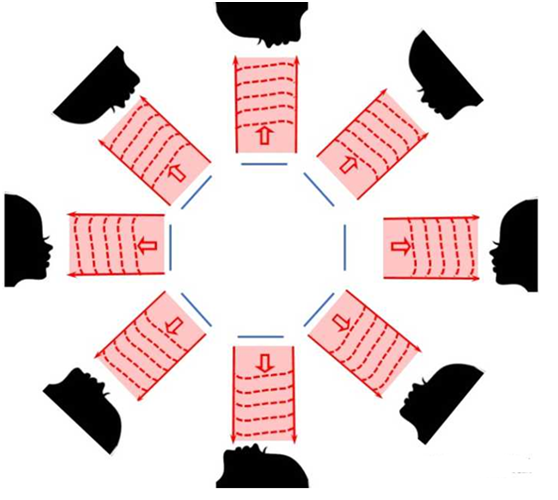
Of course, this realization is a virtual image. It can also be made into a real image and projected on a flat or three-dimensional medium. The human eye can directly see a real image. If the medium is gas, your hand can also pass through this "real" image.
Another point is that with the reproduction of light waves of different wavelengths, the color reproduction can be seen.
Fourth, "holographic" recognition
Speed Reading Edition: Pepper's Phantom (non-holographic); Rotating LED display technology (non-holographic); 3D rendering (non-holographic); "holographic" mobile phone case? "Holographic" color (non-holographic)? Recognition method: If a hologram (striped interference pattern) is used in the display process, it can be basically concluded as a "holographic".
"Holographic display"≠"3D display", not all 3D displays can be named "holographic". Talk about those 3D display technologies that have been mistaken for "holographic"
Pepper’s Vision:
As shown in the figure below, object "A" and object "B", one is on the side of the glass and the other is behind the glass. You will see both "A" and "B" directly in front of the glass.
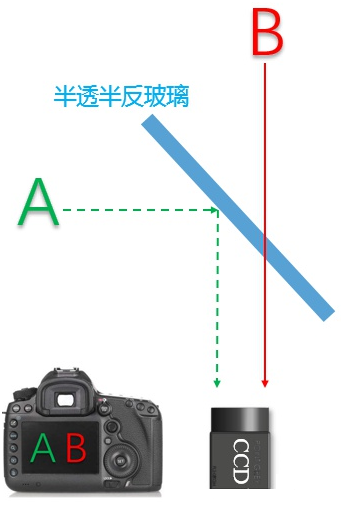
Principle of Pepper's Vision
If you still don’t understand, look at this photo again, how the car went inside the house:

Also, put a trapezoidal glass on the phone:
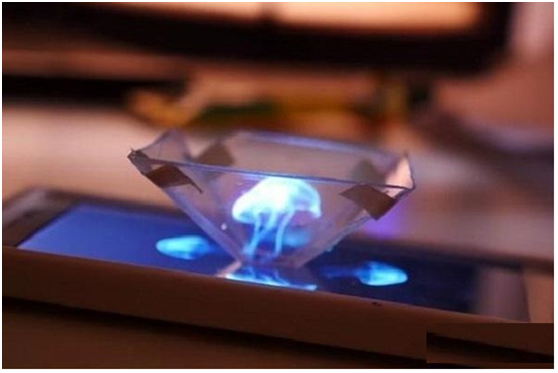
Many large-scale stage performances under the banner of "holography" (the specific ones are not named) use Pepper's illusion, which has nothing to do with holography.
2. Rotating LED display technology [4] (Looking at a fan wrapped in a circle of LEDs, there will be 3D visual effects when turned):
This technology uses the principle of persistence of vision [5] to achieve planar imaging through the high-speed rotation of the LED, but because the LED light bar is not airtight when rotating, the observer can still see the object behind the light bar, thus allowing The observer feels that the picture is suspended in the air, achieving a 3D-like effect. Some people call him "3D holographic fan screen", but this has nothing to do with "holographic".
3. 3D rendering (artificially added 3D effect in the later stage, which is a video processing method and cannot be seen in reality):
Can’t help but say, this high probability is rendered,

4. "Holographic" phone case? "Holographic" color?
Only gratings with the size of light wavelengths (pits with undulating heights) are carved on the surface, and the gratings scatter the ambient light and look colorful.
references
1.https://doi.org/10.1038/161777a0
2.https://doi.org/10.1098/rspa.1949.0075
3.https://doi.org/10.1364/OE.27.015100
4. [Patent] Lu Weiqiang, a 3D rotating full-color display [P]: China, 209029029U, 2019-06-25
5. Baidu Encyclopedia:
https://baike.baidu.com/item/%E8%A7%86%E8%A7%89%E6%9A%82%E7%95%99/5125149?fr=aladdin
